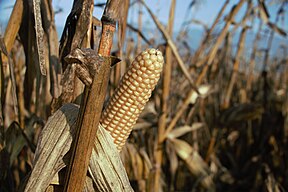Rheintaler Ribelmais
Rheintaler Ribelmais , Rheintaler Ribel or Türggenribel is a ground product made from a traditional maize variety from the Swiss Rhine Valley and Liechtenstein . Rheintaler Ribel AOP (formerly AOC) has been the only Swiss grain product with a protected designation of origin since summer 2000 . The name Ribelmais comes from the traditional dish Ribel , which is made from it.
history
In the Rhine Valley on the Swiss and Vorarlberg sides, maize plays an essential role in both cultural and economic history. Maize cultivation gained a foothold in the Rhine Valley in the 17th century, with maize coming from the Balkans from the perspective of that time, which is why the name Türggen or Türggenkorn for maize came about. The north-south facing Rhine Valley has a milder climate than the surrounding area due to the foehn influence , which means that the maize thrives excellently.
The Rheintaler Ribelmais is characterized by a great genetic diversity, since in small-scale cultivation the most beautiful cobs were used for the new sowing, and this centuries-old selection resulted in varieties that are optimally adapted to the local conditions. In general, the Ribelmais is characterized by the fact that it grows significantly better in spring under cool conditions than today's fodder maize varieties , which is why it has been included for new breeds in Switzerland in recent years.
Growing areas
The area of origin is limited to the north-south Rhine valley above Lake Constance:
- the constituencies of the Rhine Valley , Sarganserland and Werdenberg in the canton of St. Gallen
- the municipalities of Fläsch , Jenins , Landquart , Maienfeld , Malans , Untervaz and Zizers in the canton of Graubünden
- the Principality of Liechtenstein
use
The Rheintaler Ribelmais is used for the preparation of meals and groceries. In the Rhine Valley it is used for traditional corn dishes, the Rheintaler Ribelmais. The coarsely ground rib corn (Bramata) is cooked as polenta . Care must be taken to let the rib corn swell longer than other varieties. The rib corn tastes nutty.
Rheintaler Ribel
From the 18th to the 20th century, ribel was the staple food of the small farmers in the Rhine Valley. Mainly roasted, coarsely grated corn was prepared, which was previously spooned out of a large bowl with applesauce or other fruit puree or dipped into the coffee. The ribel can also be sprinkled with sugar or cocoa. The leftover ribel can be eaten for breakfast, instead of oat flakes or corn flakes, poured milk over it or soaked in coffee.
Corn beer
In 1991, on the occasion of its 100th anniversary, the Rebstein- based Brewery Bräu launched a Culinarium beer, the Rheintaler Maisbier, on the market. It is brewed from Rheintaler Ribelmais and other local ingredients. Since 2008 it has been marketed under the protected trademark Rheintaler Ribelmais Ribelgold .
whiskey
In 1999, Arnold Graf, von der Sonnenäu, began to experiment with whiskey, after the distilling of schnapps with raw materials other than pome and stone fruit was permitted in Switzerland. The result is the Rheintaler Ribel Swisslander whiskey , which was first launched in 2010.
Web links
- Rheintaler Ribelmais Association
- Rheintaler Ribelmais, Swiss AOP / IGP Association
- Ribelmais, Rheintaler Ribel in the database of Culinary Heritage of Switzerland
Comparable products:
- Linth maize flour in the database of Culinary Heritage of Switzerland
Individual evidence
- ^ Rheintaler Ribel (GUB) in the register of designations of origin and geographical indications, Swiss Confederation, Federal Office for Agriculture, order of August 7, 2000
- ↑ Detailed view of trademark no .: 575625. Swiss Federal Institute of Intellectual Property, August 21, 2008, accessed on December 31, 2013 .
- ↑ Swisslander Rheintaler Bierbrandy. Sonnenschäu AG, archived from the original on December 4, 2013 ; Retrieved November 29, 2013 .
- ↑ The whiskey from the Rhine Valley under “History” on swisslander.ch, accessed on October 22, 2019



